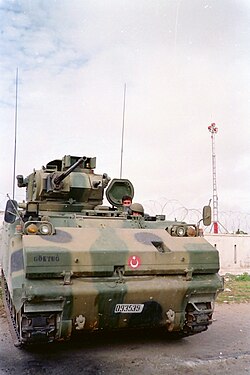FNSS ACV-15
| ACV-300 IFV | |
|---|---|
 | |
| Type | Infantry fighting vehicle |
| Place of origin | |
| Service history | |
| In service | 1992 - Present |
| Used by | See Users |
| Production history | |
| Produced | 1992 - Present |
| Specifications | |
| Mass | 14 tonnes[1] |
| Length | 5.26 m (17.3 ft) |
| Width | 2.83 m (9.3 ft) |
| Height | 2.88 m (9.4 ft) |
| Crew | 3 + 8 |
| Armor | Protection against 14.5 mm AP |
Main armament | 25mm FNSS Sharpshooter Turret |
Secondary armament | 7.62mm Machine gun |
| Engine | Detroit Diesel Model 6V-53T 300 hp |
| Power/weight | 21.43 hp/tonne |
| Suspension | torsion bar 350 mm |
Operational range | 490 km (300 mi) |
| Maximum speed | 65 km/h (40 mph) |
ACV-300 is the designation of a tracked vehicle family developed by the Turkish defense company FNSS, containing an infantry fighting vehicle (IFV) and an armoured personnel carrier (APC). The ACV-300 is based on the American Advanced Infantry Fighting Vehicle, which is based on the chassis of the M113 armored personnel carrier. It is currently in service with the armed forces of Turkey, Malaysia, the Philippines, and the United Arab Emirates.
History
FNSS developed the ACV-300 based on the AIFV to meet the Turkish Land Forces Command's (TLFC's) operational requirement. The first production vehicles were delivered in 1992. The basic AIFV has a one-person power-operated turret armed with a 25mm cannon and 7.62mm co-axial machine gun. FNSS Defense Systems' latest development is the Armored Combat Vehicle - New Generation which has an additional roadwheel each side. This can undertake a wider range of battlefield missions as it has greater internal volume and load-carrying capability. The vehicle is fully amphibious, propelled in the water by its tracks. Standard equipment includes passive night vision equipment, an NBC (nuclear, biological, chemical) protection system and smoke grenade launchers.
The AIFV is in service with Turkey 2249 and the United Arab Emirates (136 delivered). Malaysia has ordered 211 ACV-300 in different versions in 2000, all of which have been delivered.[2]
The Malaysian version of the AIFV is a result of a collaboration between FNSS and the Malaysian company DRB-Hicom Defence Technologies (Deftech). Malaysia's ACV-300 tanks are nicknamed the Adnan, after Adnan bin Saidi, a Malaysian Lieutenant who fought in the Battle of Singapore during World War II. They are manufactured locally at Pekan in Pahang.
The ACV-300 can be fitted with a number of turret choices to tailor to individual customer requirements. They are also equipped with firing ports, which allows infantrymen to fire their weapons from within the vehicle.
The Adnans feature KVH TacNav navigation system incorporating GPS, LWD Avimo laser warning device, Wegmann type 76mm grenade launchers, NBC filtration system and ANVVS-2 night vision system.
Users
Turkey has 1,698 + 551 ACV-300 in service.
The United Arab Emirates have 136 ACV-300 in service.
Malaysia has 211 ACV-300 of the following variants in service:[3]
- 72 IFV with the M2 Browning machine gun in a one-man turret
- 31 IFV with the Sharpshooter one-man turret co-developed by FNSS and BAE Systems, armed with a 25mm M242 Bushmaster chain gun
- 25 ambulance vehicles
- 24 command vehicles
- 13 signal vehicles with additional communication equipment
- 13 IFV with the Mk 19 grenade launcher in a one-man turret
- 10 vehicles armed with a 81 mm mortar
- 8 vehicles armed with the Pakistani Baktar Shikan anti-tank guided missile.
- 8+7 armoured recovery vehicles
Next to this, Malaysia has announced to purchase 48 additional ACV-300 and 8 vehicles of the stretched variant ACV-S. Those 8 vehicles will be armed with a 120 mm mortar.[4]
The Philippines acquired six (6) ACV-300s for the Philippine Army and delivered in November 2009. One (1) ARV was purchased in 2004.[5] More units to follow, although the number is still vague.
References
- Notes
- ^ All specifications according to fnss.com.tr, as of April 23, 2008
- ^ http://findarticles.com/p/articles/mi_hb4692/is_200206/ai_n17671624 as seen on 22 April 2008
- ^ According to the United Nations Register of Conventional Arms
- ^ Bernama press release as seen on April 23, 2008
- ^ AFP Modernization AFP Acquires Armor Recovery Vehicle (ARV)
